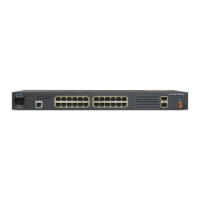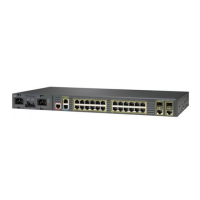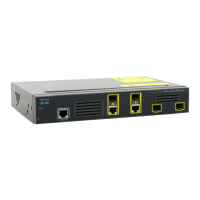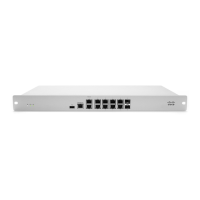34-18
Cisco ME 3400 Ethernet Access Switch Software Configuration Guide
OL-9639-07
Chapter 34 Configuring EtherChannels and Link-State Tracking
Configuring EtherChannels
Configuring the PAgP Learn Method and Priority
Network devices are classified as PAgP physical learners or aggregate-port learners. A device is a
physical learner if it learns addresses by physical ports and directs transmissions based on that
knowledge. A device is an aggregate-port learner if it learns addresses by aggregate (logical) ports. The
learn method must be configured the same at both ends of the link.
Note PAgP is available only on NNIs and ENIs.
When a device and its partner are both aggregate-port learners, they learn the address on the logical
port-channel. The device sends packets to the source by using any of the ports in the EtherChannel. With
aggregate-port learning, it is not important on which physical port the packet arrives.
PAgP cannot automatically detect when the partner device is a physical learner and when the local device
is an aggregate-port learner. Therefore, you must manually set the learning method on the local device
to learn addresses by physical ports. You also must set the load-distribution method to source-based
distribution, so that any given source MAC address is always sent on the same physical port.
You also can configure a single port within the group for all transmissions and use other ports for hot
standby. The unused ports in the group can be swapped into operation in just a few seconds if the selected
single port loses hardware-signal detection. You can configure which port is always selected for packet
transmission by changing its priority with the pagp port-priority interface configuration command. The
higher the priority, the more likely that the port will be selected.
Note The switch supports address learning only on aggregate ports even though the physical-port keyword is
provided in the CLI. The pagp learn-method command and the pagp port-priority command have no
effect on the switch hardware, but they are required for PAgP interoperability with devices that only
support address learning by physical ports.
When the link partner to the switch is a physical learner, we recommend that you configure the Cisco
ME switch as a physical-port learner by using the pagp learn-method physical-port interface
configuration command. Set the load-distribution method based on the source MAC address by using the
port-channel load-balance src-mac global configuration command. The switch then sends packets to
the physical learner switch using the same port in the EtherChannel from which it learned the source
address. Use the pagp learn-method command only in this situation.
Beginning in privileged EXEC mode, follow these steps to configure your switch as a PAgP
physical-port learner and to adjust the priority so that the same port in the bundle is selected for sending
packets. This procedure is optional.
Command Purpose
Step 1
configure terminal Enter global configuration mode.
Step 2
interface interface-id Specify the port for transmission, and enter interface
configuration mode.
Note If the interface is a UNI, you must enter the port-type
{eni | nni} interface configuration command before
configuring LACP.

